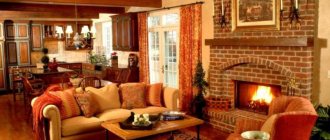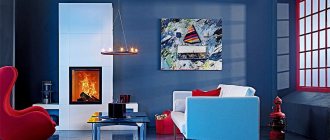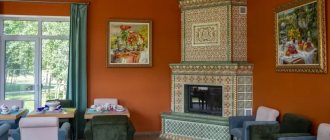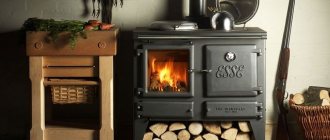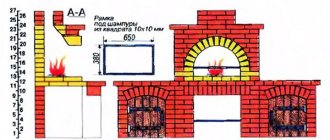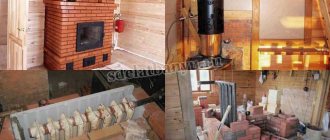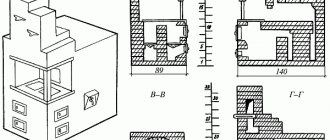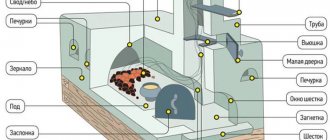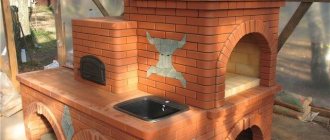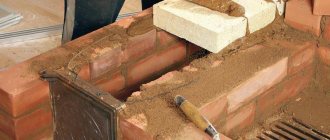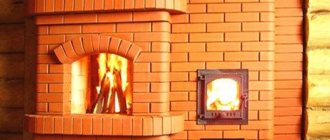Home » Type » House
House
Alyona
40430 Views 1 comment
About ten years ago, fireplaces began to be sold en masse - these are beautiful fireboxes of different sizes, made with a variety of decorative finishes. Thanks to the variety of types of portals, such fireplaces began to be installed in almost all private homes. Their beauty and high safety (the firebox is closed under glass) attracted many. For several years, they successfully replaced ancient Russian stoves. Till today…
Russian stoves in the interior
A stove in the interior has great advantages compared to a fireplace: it retains and releases heat for a long time, it does not need to be lit often.
Many models of beautiful Russian stoves are particularly economical and easy to use. It is simply impossible not to adopt such a “miracle unit”. Considering that thoughtful design significantly changes the atmosphere in the house.
Design Features
A Russian stove is easy to recognize by its design features: traditionally it has a stove bench (polati), is quite massive, often with numerous shelves for various kitchen utensils. The cooking chamber is located deep in the oven, so a special grip and skill are required to cook food in it. The basis is a guard; there are usually two dampers for smoke. Between the cooking chamber and the mouth there is a gas threshold, a wall, thanks to which the combustion products are retained under the roof and utilized more completely.
The second important design element is the inflow. It can be completely ordinary or combined with a fireplace.
Also, all furnaces can be classified according to the size of the structure:
- small;
- average;
- big.
A small dacha is often equipped with a compact stove, but a huge country house can be complemented by an unusually large structure of complex design and ornate decor.
Advantages and disadvantages
The stove, conveying the old Russian style, will be an effective addition to many interior compositions. From the point of view of efficiency and functionality, this heating option also has many advantages:
- Long cooling time;
- Good heat conservation;
- High level of efficiency;
- Long service life;
- Design safety.
However, the shortcomings are worth mentioning. The most serious disadvantage is the heat generation higher than 1 m from the floor. However, some improved designs, which involve the installation of a special smoke circulation channel, also allow the floor to be heated.
Also, a stove as a heating device requires a specific type of raw material. Firewood needs to be found, purchased, delivered and storage space organized. Fuel consumption in models of any type is quite high. It is worth considering the fact that not every interior can fit into a stove project in an ethnic direction.
Preparation of the solution
For masonry, a normal type of clay mortar is required, which has good ductility and does not crack. A thin solution is not suitable, as it crumbles a lot, while a fat solution cracks when it dries.
The composition of the masonry clay mortar will be as follows:
- fatty clay, very carefully sifted - 3 parts;
- river sand, also sifted, pre-calcined, - 3-5 parts;
- clean water for mixing - 1 part.
After mixing, you need to get a thick, viscous, greasy solution, but it should not be soft and flowing.
Various methods are used for preparation, the most optimal is soaking the clay and then adding water. When calculating the volume of mortar, it must be taken into account that when laying 50 bricks with a joint thickness of no more than 3-5 mm, approximately 20 liters of mortar are used, but experts recommend increasing this amount by 15%. The proportions of the clay mixture are 1 part sand to 2 parts clay.
When, when kneading, the consistency of the solution becomes similar to sour cream, it can be used for work. If traces of water appear on the surface of the mixture, a small amount of sand must be added. To increase strength, you can use regular salt at the rate of 100-250 grams of salt per bucket of the mixture. When laying a chimney, cement must be added to the solution at the rate of 750 grams per bucket of mixture.
Materials for the Russian stove
The design of a country house stove will largely depend on the material used. The traditional design was “sculpted” from clay. More modern models were created from brick. Stoves made of cast iron and steel also played an important role.
These are the so-called potbelly stoves. For many, they are associated with something unsightly and rude, but the modern range of mobile and compact heating devices allows you to choose quite sophisticated options.
Brick
Beautiful brick stoves for the home are the dream of true romantics and fans of Slavic flavor. A special advantage of the structures is the “breathable” material. A brick fireplace is a specific microporous body. It releases moisture vapor into the air, and when it cools, it takes it back. A stone heating unit is not capable of this.
A well-designed stove is useful for both heating and cooking. Many models of brick Russian stoves also work as a barbecue or grill.
You can build a brick stove in a small country house or in a luxurious spacious cottage. However, it is better to trust the laying of any type of structure to professionals, avoiding dubious experiments with stove-making amateurs.
Clay
A simple log house of poor people was always complemented by a clay stove. In the modern format, only finishing is made from this material and the sunbed is lubricated. Such a fireplace stove will look luxurious in the interior of a wooden house in a rustic style.
If the heating product is made exclusively on clay, then it will need to be constantly restored. It is necessary to grease and plaster at least once a year.
Cast iron
A wood-burning fireplace made of cast iron has amazing heating properties. The traditional potbelly stove appeared in the 19th century. Initially, such stoves were actively used by the Danes and Germans, and then by the Slavs.
A cast iron fireplace is like a fire: it warms you to the bone if you are in close proximity to it. If you move a decent distance away, the heat will be very soft and delicate. It does not dry out the air.
It is worth noting the disadvantages. Even a relatively small stove with cast iron elements will be very heavy. Huge structures are so heavy that they require strengthening the foundation (in some cases). In addition, cast iron is quite expensive when it comes to expensive materials.
A simple potbelly stove in the interior of a miniature wooden house will always look very stylish. A small unit with ornate “old-fashioned” decor and wooden log walls, a cozy blanket with embroidery and original patterns, indoor flowers - all this will give a person a feeling of calm, relaxation and privacy.
Steel
By analogy with classic cast-iron structures, steel stoves began to be produced. In large units, some elements (for example, the firebox) are replaced with steel ones.
Almost always, the fireboxes of steel furnaces can be lined - they are laid out with fireclay bricks. This is necessary to give the fabric greater heat resistance. You can additionally install tiles on the steel body. It is very fashionable to decorate fireboxes with natural or artificial stone.
Steel structures are much lighter than cast iron prototypes. They are much cheaper, much more mobile in terms of movement (if we are talking about devices like potbelly stoves).
Getting to know the procedures
A stove whose wood-burning compartment is lined with bricks must be assembled partially from fireclay bricks. In order for such a design to work properly, order is necessary. You can find the diagram on websites and in specialized literature. Individual projects are made to order only.
Since the Russian stove is a classic solid fuel design, it is necessary to approach the choice of a craftsman responsibly and give preference to a stove maker who is familiar with the technology of laying old stoves. This way, you will be confident that the stove will work properly and will not malfunction.
The classic order includes a variant with forty rows. Before laying, an additional foundation is traditionally assembled, and the first row of bricks must be perfectly level. The last two rows of the order are the chimney.
On the second row, chimney channels begin to form, leaving space for the combustion chamber and other provided structural elements. Other rows are laid in a similar manner, up to and including the fifth.
On the sixth row, a combustion chamber equipped with a door is installed. In order for air masses to circulate and move evenly, decorative ventilation grilles are installed. The combustion hole stacks are laid using refractory stove bricks. Next, we lay the 7th and 8th rows, make a short circuit at 9th and block the lower passage channel.
On rows 11-13 we form an arched crucible. Next, by analogy, rows laid in the shape of a chimney are assembled. At the necessary stages we install the closing and sliding elements.
Additional materials
Auxiliary parts and additional materials for a traditional Russian stove are not only functional elements, but also serve as effective decor. When working on the creation and design of a stove with a stove bench, you may need the following:
- brick;
- sand;
- accessories for stoves;
- grate;
- valves;
- corners;
- fireclay slabs;
- fireclay brick;
- tile;
- ceramics;
- stone cladding;
- basalt insulation.
The old Russian stove is very economical in everyday life. She will decorate a modern country cottage, and housewives will appreciate her ability to prepare original dishes.
Types of cladding for furnace devices
Before carrying out work on lining the furnace, you should very carefully select the material to change the appearance of the furnace device. Properties to consider when choosing materials:
- high temperature resistance;
- good heat dissipation;
- mechanical reliability, practicality;
- strength of adhesion to the solution;
- aesthetic appeal.
Most often, materials with a thickness of at least 6 mm with a low-porosity structure are used for lining the furnace.
Since ancient times, brick, natural stone, tiled material, and ceramic tiles have been used to change the appearance of the stove. Modern industry offers artificial stone, as well as soapstone, for such work.
Features of masonry
A modern country house requires a special approach to the laying and design of such a complex and powerful heating unit. First they make a backfill - a chamber. It acts as a kind of battery, retaining heat in the house.
The cooking chamber is covered with a roof. It is designed strictly according to the formwork - plank or metal. When laying bricks, they are placed on both sides at once. The angle of inclination will depend on the shape of the arch. This is necessary so that the load is evenly distributed throughout the structure. At the end of the work, the master forms a wedge castle from brick.
The chimney is installed in the furnace itself. The height of the element must be higher than 5 m from the level of the blind hearth. There are no horizontal sections or turns needed. A well-formed vertical (like for a fireplace) is enough.
Furnace finishing
The firebox is finished with the same materials as the stove itself. The main condition when choosing materials is safety, fire resistance, reliability, and strength. When designing the firebox, special attention should be paid to fire safety rules, because this part is most directly related to fire.
It is very important to leave a gap between the firebox and the stove lining. This is necessary for free air circulation, which affects the efficiency of its operation as a whole. It is not advisable to fill this gap with sand or thermal insulation material. It will become a reliable obstacle to deformation of the facing material. If there is a gap, then the finishing material will not crack, voids or other negative aspects will not appear in it.
When using plasterboard structures, leaving a gap will be an additional means against fire. 10 centimeters is the minimum gap that must be left between the firebox and the stove for safety reasons.
Where is a Russian stove installed?
In ancient times, at the stage of building houses, they first of all determined where the stove would be located in the house, as well as the bathhouse on the estate. And if not everyone had steam rooms, then they simply could not do without a heating unit.
When choosing the optimal location, the operating principle of the stove, the possibility of further connection of the chimney and ease of maintenance during operation are taken into account. Fire breaks must be calculated - the distance between heating surfaces and walls made of flammable materials.
If the cottage is small, then it is better to place the stove as centrally as possible in the house. The same rule is relevant if the country house is entirely wooden.
In the living room
If the house is large and has many rooms, the ideal place to install the stove is the living room (even if we are not talking about traditional large units, but about miniature potbelly stoves or modern electric fireplaces).
For a large house it is better to create brick structures. Such a stove will warm up spacious rooms well. Typically, the living room is the center of the home.
By placing a stove in it, you can warm up all the rooms. Of course, the design will take quite a lot of time, but it is at the planning stage that it is important to take into account all the subtleties.
For example, to heat a village house consisting of four rooms, the stove is placed at the junction of the two main rooms. The “antique” format of the stove – with a stove bench – will look good in the living room.
Installation in the kitchen
Installation in the kitchen is the second common option for placing a stove in the traditional Russian style. As a rule, this technique is used in several cases:
- Only one room needs to be heated. Usually this is the kitchen or remote living room. A similar need arises when there is a good heating system throughout the house (for example, a gas boiler with a water circuit) and there is a shortage of heat in one of the rooms. Often, it is the kitchen that is being completed or its main structural components are being changed, which requires additional heating.
- A stylish Dutch or Russian “mazanka” skillfully emphasizes a thoughtful interior. Experiments with gastronomic-themed decor and decorations in ethnic style very often go well with the decoration of expensive kitchen locations in country, ethnic, and rustic styles.
- The stove plays the role not so much of a heating device, but rather of a device for cooking. A well-formed design and skillfully selected place will allow you to bake delicious pies, heat a vat of water, experiment with a device with an original barbecue system or grill.
The stove in the kitchen is also located in very small houses. In this case, it is the heating element that becomes the “hot heart” of the whole house. The well-thought-out design of the stove helps to correctly delimit space and divide a compact location into zones.
Historical reference
The presence of a Russian stove has become a real legend - previously such heating structures were installed in every private house. They have become an integral part of Russian folklore. Even today it is difficult to find a replacement for a Russian stove, taking into account its reliability!
It is not known exactly when they began installing similar structures for heating homes in Russia. According to approximate data, their prototypes appeared 4 thousand years ago, when people decided to equip their house with the ability to make a fire hidden under clay materials.
Stove in a rural wooden house
In Rus', stoves were distinguished by the peculiarity of their masonry. Until the 13th century, the most common variants were chimneys, in which there were no chimney pipes facing the street. In such options, smoke escaped from the premises due to drafts through the door, but at the same time, soot constantly settled on any surfaces, which caused a lot of inconvenience.
However, the usual version appeared only in the 18th century. Then they were made of bricks with fire-resistant properties, they had chimneys. At that time, such structures were placed exclusively in the corners of huts, not far from the front door. It was permissible to leave a small space between the wall and the stove, where various kitchen utensils were stored.
Kitchen design with a stove in a rustic style =»ltr»>
Historically, the stove is used in several styles: country, Provence, rustic, chalet. For example, for Americans, a rustic interior means country details, for the French it’s romantic Provence, and for Swedes it’s a rural chalet. All of them are rustic, so the layout and decoration of the building is similar. The main features of a rustic kitchen with an oven are natural shades, natural materials and homemade decor.
In rural interiors, the colors of wood and stone predominate - brown, beige, gray, white. Natural timber and stone are used as the basis for finishing and furniture. Materials for creating decor or small-sized furniture - rattan, straw, metal (implies the use of forged elements). To create a warm, cozy environment, an abundance of textiles is a must: curtains with floral patterns, embroidered tablecloths and napkins made of cotton or linen, decorative pillows and bedspreads with decor will become the highlight of the room.
Usually the oven is placed in the kitchen
Rural interiors are dominated by the colors of wood and stone.
See alsoRustic style in the interior
Design of a small kitchen with an oven =»ltr»>
Antique stoves can be used very advantageously in a modern interior. To do this, you need to pay attention to details: colors, lighting and proper use of space. Light shades – white, ivory, beige – will help to make the area visually wider. To prevent the space from seeming boring and monotonous, you can dilute it with bright details. For example, decorate a Russian stove with multi-colored mosaics, hang curtains with spectacular patterns. Excessive drawings can reduce the size of a kitchen with a stove.
Lighting in a small kitchen should be central (chandelier) and local (above the work area). It is better to use cold incandescent lamps, as their white color advantageously expands the space. And the last point is the rational use of space: the location of furniture, stove. In a small room, the use of bulky furniture sets is unacceptable.
To prevent the stove from being monotonous, you can cover it with tiles
Antique stoves can be used very profitably in a modern interior
See alsoKitchen in a country house
How to decorate a stove
There is nothing more original than the use of authentic materials and extravagant techniques in the design of modern apartments. The design of the Russian stove is quite unusual and can complement the beautiful design of the room.
If once the stove played a functional role and was the “center of everyday life” in a home, now its purely aesthetic role has increased. An impressively designed and decorated stove will enrich any modern interior.
Considering the fact that stoves can also be placed on the street, the entire private sector is transformed as soon as a cozy and “elegant” fireplace appears on the site.
Decorating the stove with tiles
Tiles are three-dimensional ceramic tiles that are used for finishing stoves, facades of buildings, and any other structures. The decoration has one distinctive feature - the rump. This is a box with holes through which the decor is attached to the wall.
Tiles come with a smooth surface and a relief canvas, plain and painted with bright patterns, rectilinear design and complex shapes. The decor can be turned into a monochromatic elegant panel or you can create a complex colorful installation with an abundance of decorative techniques.
A special artistic merit of such jewelry is majolica, which can change color at different times of the day. The decoration will show its qualities well in spacious, bright rooms.
The design of a Russian stove using tiled elements has the following advantages:
- Hygiene. They do not accumulate dust and dirt, do not darken over time and are not deformed. The special composition of the glaze does not allow soot and carbon deposits to penetrate inside the decorative ball.
- Highest level of heat capacity. The current eco-friendly format of modern rational heating of housing involves the use of only those heating devices whose efficiency is as high as possible. Tiled decor has a special heat capacity, improving the technical characteristics of the stove as a whole.
- Long heat dissipation. The oven cools down much more slowly.
Decorating a Russian stove with tiles is a complicated matter. Not every stove maker will undertake such work. Ideally, several specialists are involved in the work at once - an experienced stove maker or ceramist, as well as an architect or designer artist.
Plaster and paint
A classically plastered stove looks beautiful and cozy. There are many reasons why the old format of finishing heating units has retained its relevance today:
- Plaster allows you to level even a crooked structure, making the stove more elegant and attractive;
- A beautiful finish gives the old structure a fresh look.
- A large number of types of plastering and a solid range of materials allow us to implement any design project.
The easiest way to decorate a stove after plastering is to whitewash it.
You can do this yourself. A cheap and simple method will not allow you to use the stove to its full potential, since the bleached surfaces will get dirty. Another option (more practical) is the use of paints. If you cover the fireplace with oil and enamel compounds, you can increase heat transfer. Glossy and shiny paints work in the opposite direction. Formulations containing oil may darken under prolonged exposure to high temperatures.
Decorating the stove with tiles
Tiles are an expensive design material for finishing stoves. There is an excellent alternative (more attractive in terms of pricing) - tiles. Tiles or ceramics are presented in such a wide range that such decorative elements can be found in any form. They are suitable for creating unimaginable panels and complex decoration.
Another alternative option is porcelain stoneware or artificial stone. This is a relatively inexpensive material that looks magical in any interior.
The slightly rough textured background is complemented by wooden decorative elements. It turns out very colorful.
Decorate with household items
There are a lot of options for designing a stove in terms of decorative elements. It all depends on the specific stylistic direction in which the stove itself is presented:
- "a la russe";
- hut;
- tower;
- Noble Nest;
- estate in neoclassical format.
An apartment or house decorated using several stylistic concepts at once looks even more interesting. If desired, even a boiler or fireplace corner can be decorated in an incredible way.
Beauty majolica
The tiles, painted with bright fiery colors and covered with a durable layer of glaze, came from the Mediterranean. Ancient Roman traders brought it from Mallorca. The area was famous for its tin-lead painting on ceramic tiles and pottery.
Glazing serves as another layer that retains heat inside the finishing material, so majolica was in demand as an excellent type of cladding.
Only wealthy people could decorate their stoves with such beauty.
A la russe
The “a la russe” style involves the use of traditional authentic elements of Russian life. Once upon a time, classics were written about stoves with such decor. Shelves were placed near the whitewashed hearth.
Wood is an absolute favorite. The main decorative elements are samovars, brooms and spinning wheels, animal skins (not exotic) and towels with embroidered ornaments. It is not at all necessary to decorate the stove with drawings. A perfect white background is enough.
Do it yourself
In order to cover a brick stove with tiles with your own hands, you need to carry out preparatory work and prepare the tools needed for the job:
- rack level and plumb line;
- construction trowel and spatula;
- paint brush (it’s better to take a wide one);
- special tile cutter;
- a hammer or mallet with a rubber top;
- a brush with metal bristles;
- convenient container for the solution;
- fireproof heat-resistant adhesive.
This article will help you deal with the repair of a brick stove:
Decorating a stove with tiles is not an easy process, so professionals are invited for such work, but laying tiles can be done by an owner with good hands.
- To begin with, the stove is cleaned of the mortar remaining after laying. This is best done with a wire brush and rubbing with a damp rag or sponge.
- Cover and secure a special metal mesh over the entire surface (mesh size no more than 20mm). Self-tapping screws or nails are used as fasteners.
- The structure with the mesh is plastered with mortar, leveled and allowed to dry. At the end of drying, when the solution no longer cracks, the oven is heated well.
- They begin to glue the tiles. Masters recommend starting from the corners and bottom rows. To make the rows even, use a level and crosses.
- The simplest and most enjoyable stage is grouting the joints and applying a heat-resistant compound. Before grouting the seams, allow the entire structure to dry for about three days. After this, you can remove all construction debris and wash the tiles.
Unique design of plasterboard ceilings photo for inspiration
Decorative fireplace made of plasterboard: how to make it yourself
You will be able to make a decorative fireplace with your own hands from plasterboard if you follow the step-by-step instructions. Think about the dimensions in advance, use the drawings, and the design of the room will be transformed...
- dimensions (height, length and width) of the fireplace base;
- similar portal parameters. Only in this case should the width be changed to depth;
Dry plaster...
is a popular material today, which is sold in the form of ready-to-use mixtures. Depending on the main components and fillers used...
Sources
- https://okno-pro.ru/pech/russkaya-v-sovremennom-interere.html
- https://PechDvorik.ru/remont/pechka-v-spalne.html
- https://roomester.ru/dom/russkie-pechi-v-sovremennom-interere.html
- https://www.dizainvfoto.ru/interer/kuxnya/russkaya-pechka-v-interere-nepovtorimyj-dizajn-sovremennogo-doma.html
- https://m-strana.ru/design/kukhnya-s-russkoy-pechyu-v-derevyannom-dome-perezhitok-ili-sovremennaya-interpretatsiya/
- https://7dach.ru/FrolovaEkaterina/russkaya-pech-v-interere-sovremennogo-zagorodnogo-doma-49105.html
- https://imerica.ru/kaminy-i-pechi/otdelka.html
- https://online-simpsony.ru/remont-i-dizajn/interer-gostinoj-s-pechkoj.html
[collapse]
Russian hut and tower
The stylistic concept of “Russian hut” involves the use of wood. It can only be an imitation, but it must be skillful and thoughtful. In some ways, this direction is reminiscent of a loft, but it is much more dynamic and elegant than the “concrete jungle” style. The main difference from the previous style is that each decorative element has its own functional purpose.
A house in the “Russian tower” style is radically different from other styles. Planning plays an important role here. In villages, many people still decorate their yard in this style. Key features: the presence of garden decor, bright colors, ornate carvings, an abundance of tiles, colorful patterns, bright decor.
Tile - man-made beauty
This is a beauty created from different types of clay. The manufacturing technology came from ancient Babylon and has survived to this day. The tile is a box shape, thanks to which heat retention increases significantly.
This is a piece and expensive finishing material. In past centuries, only very wealthy people could cover a stove with tiles.
Beautiful boxes, each with an individual design, were incredibly expensive, but were in great demand.
Nowadays, tiles are also popular.
Other directions
Traditional Russian stoves with couches in modern apartments are often decorated in ethnic styles, very far from Slavic symbols. The most fashionable formats are oriental and Mexican.
The Russian stove in the interior of houses is a wonderful element that decorates the location and gives the room a unique atmosphere of comfort and homely warmth. With the help of the right design and well-chosen decor, you can turn your home into a real work of art.
Porcelain tiles
Its creation dates back to the 80s of the last century. Porcelain stoneware is intended not only for finishing stoves, but is also widely used in construction. To produce it, several types of special clay are required with the addition of quartz sand, various types of natural dyes and a fine fraction of marble or granite.
The whole mass is well kneaded and pressed at fairly high temperatures under pressure. The result is a durable product that is not afraid of strong impacts and high temperatures, and retains heat well.
This is a monolithic material that can be given any color during manufacturing.
Thanks to modern technologies, porcelain stoneware can be made in the form of majolica, terracotta or tiles. The cost of such material is not high in comparison with the original ones.
